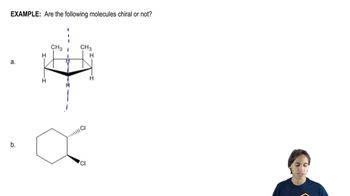Here are the essential concepts you must grasp in order to answer the question correctly.
Chirality
Chirality is a property of a molecule that makes it non-superimposable on its mirror image, much like left and right hands. A chiral object typically has an asymmetric carbon atom, which means it has four different substituents attached to it. In the context of the question, chirality can be assessed by determining if the arrangement of letters on the mugs creates a mirror image that cannot be aligned with the original.
Recommended video:
Symmetry
Symmetry refers to the balanced proportions and arrangement of parts in an object. An object is considered symmetric if it can be divided into two identical halves that are mirror images of each other. In assessing the mugs, understanding symmetry helps identify whether the arrangement of letters creates a situation where the mug can be superimposed on its mirror image, indicating a lack of chirality.
Recommended video:
Determining Chirality with Plane of Symmetry
Optical Activity
Optical activity is the ability of chiral substances to rotate the plane of polarized light. This property arises from the asymmetry of chiral molecules. While the question focuses on physical objects (mugs), understanding optical activity is crucial in organic chemistry as it relates to the behavior of chiral compounds in solution, which can be a key indicator of their chirality.
Recommended video:
Mutorotation and Optical Activity
 Verified step by step guidance
Verified step by step guidance Verified video answer for a similar problem:
Verified video answer for a similar problem:



 1:25m
1:25m